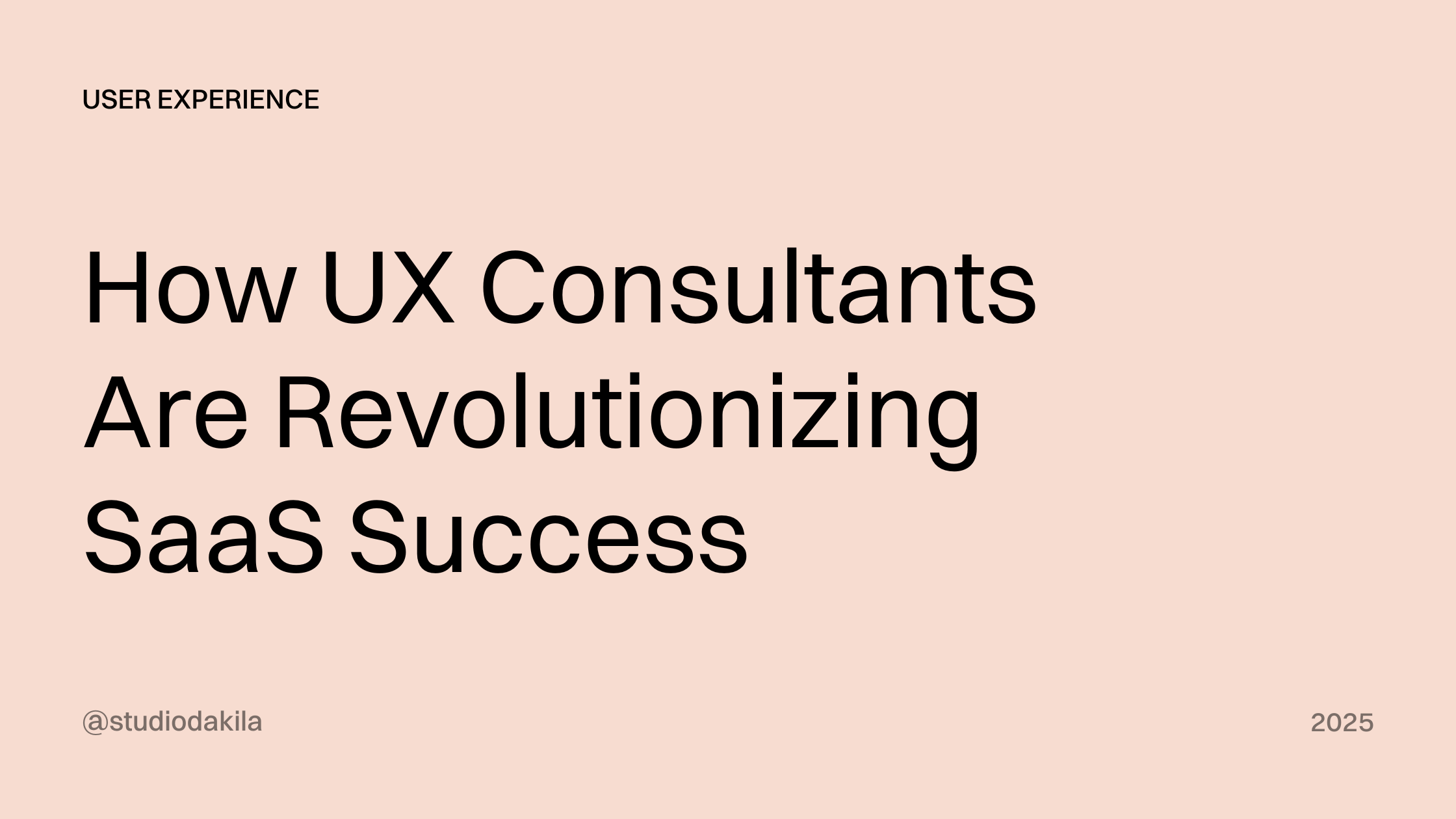Most SaaS products fail not because they lack features, but because users can’t figure out how to use them. This disconnect between functionality and usability represents one of the most significant challenges facing SaaS companies today. We build sophisticated platforms with powerful capabilities, yet users abandon them in frustrating numbers when the learning curve proves too steep.
Enter the ux consultant – a strategic specialist who serves as the critical bridge between what developers create and what users actually need. In an increasingly competitive SaaS landscape, their role has evolved from optional enhancement to strategic necessity for companies seeking sustainable growth and improved business outcomes.
Understanding the Role of a UX Consultant
A UX consultant is a specialized professional who analyzes, refines, and optimizes how users interact with digital products. They combine research methodology, design principles, and business strategy to ensure products deliver both functional value and intuitive usability.
Unlike in-house designers who may be constrained by established patterns and internal biases, a UX consultant brings fresh perspective and specialized expertise to identify problems that insiders often miss. Research shows that for every $1 invested in UX, companies see an approximate return of $100, representing a 9,900% ROI.
Core Responsibilities of UX Consultants
User Research and Analysis: Conducting interviews, surveys, and usability tests to gather insights about user behaviors, needs, and pain points. This foundation enables data-driven design decisions that directly impact business metrics.
Strategic Journey Mapping: Documenting the complete user journey to identify friction points and opportunities for enhancement. This comprehensive approach often reveals conversion rate optimization opportunities that traditional analysis might miss.
Prototype Development: Creating visual representations of potential solutions for testing before full implementation. This iterative process reduces development costs while ensuring solutions address actual user needs.
Implementation Guidance: Working with development teams to ensure designs are implemented correctly, maintaining design integrity throughout the development process.
How UX Consultants Drive SaaS Transformation
In the SaaS industry specifically, a UX consultant faces unique challenges and opportunities. The subscription-based business model means that user retention is as important as acquisition, creating distinct strategic requirements that demand specialized expertise.
Optimizing Critical User Flows
A skilled ux consultant focuses on optimizing user flows that directly impact business outcomes. They work closely with product managers and developers to align design with business goals, ensuring that technical capabilities translate into meaningful user experiences.
This collaboration is essential because SaaS products often contain complex functionality that must be made accessible to users with varying levels of technical expertise. The strategic approach involves understanding both user needs and business constraints to create solutions that serve both effectively.
Enhancing Onboarding for Better Conversion
The first experience a user has with a SaaS product often determines whether they’ll become a long-term customer or abandon the platform entirely. A UX consultant designs onboarding processes that gradually introduce users to key features without overwhelming them.
This staged approach helps users reach their “aha moment” quickly, increasing the likelihood of conversion from free trial to paid subscription. Companies implementing these strategic onboarding improvements have seen conversion rates increase by up to 400%.
Strategic Feature Integration
As SaaS products evolve, they tend to accumulate features that can clutter the interface and confuse users. A UX consultant helps businesses streamline their digital products through data-driven design decisions that optimize user engagement and satisfaction.
This process often involves working with teams that specialize in conversion rate optimization to ensure that interface improvements translate directly into business growth. The strategic integration of ui ux design agency principles with business objectives creates sustainable competitive advantages.
The Strategic Methodology Behind UX Consulting
Effective UX consultants follow a structured methodology that balances creative exploration with analytical rigor. This strategic approach ensures that recommendations align with both user needs and business objectives.
Discovery and Strategic Analysis
Understanding the business context, technical constraints, and existing user patterns before making recommendations. This phase typically involves stakeholder interviews, competitive analysis, and review of existing user data to understand not just what the product does, but the business objectives it serves.
Research-Driven Insights
Gathering insights directly from users through various qualitative and quantitative methods. This might include contextual inquiries or structured usability tests that measure specific metrics like time-on-task or error rates, providing the foundation for strategic recommendations.
Solution Design and Validation
Creating solutions that address identified problems while maintaining consistency with the overall product experience. This iterative process involves multiple rounds of wireframing, prototyping, and testing to refine concepts before development begins.
The validation phase includes testing proposed solutions with actual users to ensure they solve intended problems without creating new ones, preventing companies from investing resources in changes that don’t actually improve user experience.
Strategic Timing for UX Consulting Engagement
Timing is critical when engaging a UX consultant. The right moment varies based on your company’s stage and specific challenges, but several indicators suggest UX intervention would provide strategic value.
Early Development Integration
Involving a UX consultant early in the product development cycle yields substantial cost savings and risk mitigation benefits. By identifying usability issues before code is written, companies avoid expensive redesigns while ensuring alignment with actual user needs rather than assumed ones.
Performance Optimization Opportunities
High bounce rates, low conversion rates, or declining retention often signal user experience issues that require strategic intervention. A UXconsultant can conduct diagnostic research to identify specific friction points, then recommend targeted improvements that directly impact business metrics.
Market Expansion Strategy
When expanding to new markets, different user segments often have different expectations and behaviors. A UX consultant can research new target markets to ensure product adaptations meet their specific needs, supporting successful market expansion initiatives.
Measuring Strategic Impact
The value of UX consulting becomes evident through both quantitative metrics and qualitative outcomes. Smart companies track these indicators before and after UX interventions to measure strategic success.
Conversion Rate Improvements: Enhanced UX typically leads to higher conversion rates as friction points are removed from critical pathways, directly impacting revenue growth and customer acquisition costs.
User Retention Optimization: This metric is particularly important for SaaS companies, as their business model depends on ongoing subscriptions rather than one-time purchases. Strategic UX improvements often result in measurable retention improvements.
Support Cost Reduction: Effective UX improvements often reduce support costs by making products more intuitive and self-explanatory, creating operational efficiency gains that compound over time.
Maximizing Consulting Engagement Value
To maximize the strategic value of UX consulting engagements, companies should follow proven best practices that ensure successful collaboration and implementation.
Clear Strategic Objectives
Articulate what success looks like before engagement begins. Specific goals help consultants focus efforts on highest-impact areas rather than trying to address every possible improvement opportunity.
Cross-Functional Integration
Include product managers, developers, and marketers in key meetings with UX consultants. This collaborative approach ensures all perspectives are considered and increases buy-in for eventual recommendations.
Implementation Planning
Allocate resources for implementing recommendations before receiving them. Too many valuable UX insights go unused because companies fail to budget time and resources for making suggested changes.
The Evolution of Strategic UX Consulting
As the SaaS industry continues to mature, several trends are shaping the evolution of UX consulting, creating new opportunities for strategic advantage.
AI-Enhanced Research Capabilities
Machine learning tools are enabling UX consultants to analyze larger datasets and identify patterns that might escape human observation. These tools augment human expertise, allowing consultants to focus more on interpretation and strategic recommendations.
Domain Specialization
UX consultants are developing deeper knowledge in specific domains like fintech, healthcare, or enterprise software. This specialization allows them to provide more targeted recommendations based on industry-specific user expectations and regulatory requirements.
Continuous Strategic Partnership
Rather than one-off projects, many companies are moving toward ongoing relationships with UX consultants. This approach enables measurement of recommendation impact and continuous refinements as user needs evolve.
Integration with Comprehensive Digital Strategy
The most successful SaaS companies recognize that user experience optimization works best when integrated with broader digital strategies. This includes coordination with SEO services to ensure that improved user experiences translate into better search visibility and organic growth.
Understanding UI UX design secrets that drive user engagement while maintaining technical performance creates sustainable competitive advantages. The strategic integration of user experience principles with conversion rate optimization methodologies ensures that design improvements directly impact business outcomes.
Companies that work with a comprehensive UI UX design agency approach often see compounding benefits, as improved user experiences lead to better customer satisfaction, higher retention rates, and more effective word-of-mouth marketing.
Key Takeaways:
- UX consultants provide strategic expertise that transforms complex SaaS functionality into intuitive user experiences that drive business growth.
- Strategic UX investments typically deliver measurable returns through improved conversion rates, user retention, and reduced support costs.
- Successful UX consulting engagements require clear objectives, cross-functional collaboration, and dedicated resources for implementation.
Ready to Bridge the Gap Between Features and User Success?
Our experienced UX consultants specialize in transforming complex SaaS products into intuitive experiences that users love and businesses profit from. We combine strategic analysis with proven methodologies to deliver measurable improvements in conversion rates, user retention, and overall business performance.
Frequently Asked Questions
A UX consultant brings specialized expertise and fresh perspective without internal biases, focusing specifically on strategic user experience improvements that drive business outcomes.
Most companies see initial improvements within 6-8 weeks of implementing strategic UX recommendations, with full impact becoming evident over 3-6 months.
Define clear business objectives, gather existing user data and analytics, and ensure access to actual users for research and testing purposes.

